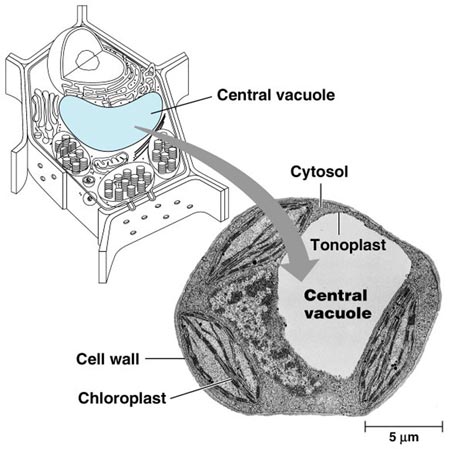

Vacuole
This is a vacuole with a single surrounding membrane called the tonoplast. The vacuole is the toxic waste dump for the plant cell. Phenolics, acids, and a range of nitrogenous wastes are held here, away from the cytosol. The water-soluble pigments are generally held here too. Chief among these are the family of pigments known as anthocyanins. These pigments are responsible for red-pink-blue-purple coloration in many (but not all) flowers and fruits.
The tonoplast (vacuole membrane) is an interesting membrane. It has transport proteins for a range of materials to be held inside the vacuole. These transport proteins are mostly active-transport carriers. If you think about why that is so, you will probably answer the question easily. I'll leave that for you to do on your own!
As a cell ages the onset of death is usually associated with tonoplast leakage and breakdown.
Occurs in animal and plant cells but much more prominent in plants. May take up 90% of the volume of the cell. Actually gives structural support to the cell. Membrane bound (vacuolar membrane or tonoplast), much like the plasma membrane. Storage vesicle for water, sugars, salts, pigments, as well as toxic substances such as acids, tannins, alkaloids, latex, etc. Serves to isolate these compounds from the cell itself. Think of this as a water reservoir!
Vacuoles are membrane-bound sacs within the cytoplasm of a cell that function in several different ways. In mature plant cells, vacuoles tend to be very large and are extremely important in providing structural support, as well as serving functions such as storage, waste disposal, protection, and growth. Many plant cells have a large, single central vacuole that typically takes up most of the room in the cell (80 percent or more). Vacuoles in animal cells, however, tend to be much smaller, and are more commonly used to temporarily store materials or to transport substances.
The central vacuole in plant cells (see Figure 1) is enclosed by a membrane termed the tonoplast, an important and highly integrated component of the plant internal membrane network (endomembrane) system. This large vacuole slowly develops as the cell matures by fusion of smaller vacuoles derived from the endoplasmic reticulum and Golgi apparatus. Because the central vacuole is highly selective in transporting materials through its membrane, the chemical palette of the vacuole solution (termed the cell sap) differs markedly from that of the surrounding cytoplasm. For instance, some vacuoles contain pigments that give certain flowers their characteristic colors. The central vacuole also contains plant wastes that taste bitter to insects and animals, while developing seed cells use the central vacuole as a repository for protein storage.
Among its roles in plant cell function, the central vacuole stores salts, minerals, nutrients, proteins, pigments, helps in plant growth, and plays an important structural role for the plant. Under optimal conditions, the vacuoles are filled with water to the point that they exert a significant pressure against the cell wall. This helps maintain the structural integrity of the plant, along with the support from the cell wall, and enables the plant cell to grow much larger without having to synthesize new cytoplasm. In most cases, the plant cytoplasm is confined to a thin layer positioned between the plasma membrane and the tonoplast, yielding a large ratio of membrane surface to cytoplasm.
The structural importance of the plant vacuole is related to its ability to control turgor pressure. Turgor pressure dictates the rigidity of the cell and is associated with the difference between the osmotic pressure inside and outside of the cell. Osmotic pressure is the pressure required to prevent fluid diffusing through a semipermeable membrane separating two solutions containing different concentrations of solute molecules. The response of plant cells to water is a prime example of the significance of turgor pressure. When a plant receives adequate amounts of water, the central vacuoles of its cells swell as the liquid collects within them, creating a high level of turgor pressure, which helps maintain the structural integrity of the plant, along with the support from the cell wall. In the absence of enough water, however, central vacuoles shrink and turgor pressure is reduced, compromising the plant's rigidity so that wilting takes place.
Plant vacuoles are also important for their role in molecular degradation and storage. Sometimes these functions are carried out by different vacuoles in the same cell, one serving as a compartment for breaking down materials (similar to the lysosomes found in animal cells), and another storing nutrients, waste products, or other substances. Several of the materials commonly stored in plant vacuoles have been found to be useful for humans, such as opium, rubber, and garlic flavoring, and are frequently harvested. Vacuoles also often store the pigments that give certain flowers their colors, which aid them in the attraction of bees and other pollinators, but also can release molecules that are poisonous, odoriferous, or unpalatable to various insects and animals, thus discouraging them from consuming the plant.